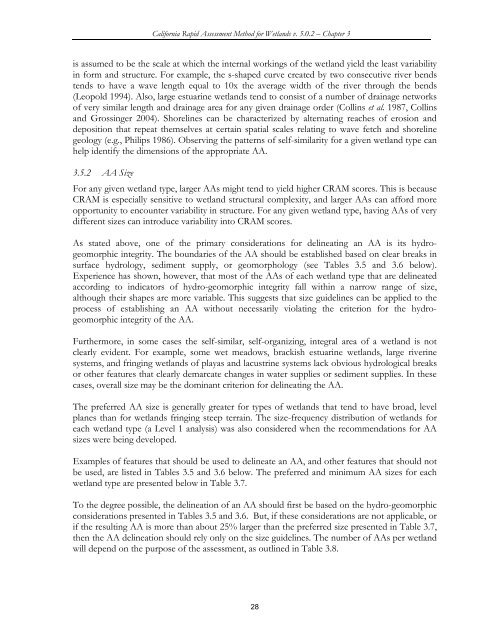California Rapid Assessment Method for Wetlands - State Water ...
California Rapid Assessment Method for Wetlands - State Water ...
California Rapid Assessment Method for Wetlands - State Water ...
You also want an ePaper? Increase the reach of your titles
YUMPU automatically turns print PDFs into web optimized ePapers that Google loves.
<strong>Cali<strong>for</strong>nia</strong> <strong>Rapid</strong> <strong>Assessment</strong> <strong>Method</strong> <strong>for</strong> <strong>Wetlands</strong> v. 5.0.2 – Chapter 3<br />
is assumed to be the scale at which the internal workings of the wetland yield the least variability<br />
in <strong>for</strong>m and structure. For example, the s-shaped curve created by two consecutive river bends<br />
tends to have a wave length equal to 10x the average width of the river through the bends<br />
(Leopold 1994). Also, large estuarine wetlands tend to consist of a number of drainage networks<br />
of very similar length and drainage area <strong>for</strong> any given drainage order (Collins et al. 1987, Collins<br />
and Grossinger 2004). Shorelines can be characterized by alternating reaches of erosion and<br />
deposition that repeat themselves at certain spatial scales relating to wave fetch and shoreline<br />
geology (e.g., Philips 1986). Observing the patterns of self-similarity <strong>for</strong> a given wetland type can<br />
help identify the dimensions of the appropriate AA.<br />
3.5.2 AA Size<br />
For any given wetland type, larger AAs might tend to yield higher CRAM scores. This is because<br />
CRAM is especially sensitive to wetland structural complexity, and larger AAs can af<strong>for</strong>d more<br />
opportunity to encounter variability in structure. For any given wetland type, having AAs of very<br />
different sizes can introduce variability into CRAM scores.<br />
As stated above, one of the primary considerations <strong>for</strong> delineating an AA is its hydrogeomorphic<br />
integrity. The boundaries of the AA should be established based on clear breaks in<br />
surface hydrology, sediment supply, or geomorphology (see Tables 3.5 and 3.6 below).<br />
Experience has shown, however, that most of the AAs of each wetland type that are delineated<br />
according to indicators of hydro-geomorphic integrity fall within a narrow range of size,<br />
although their shapes are more variable. This suggests that size guidelines can be applied to the<br />
process of establishing an AA without necessarily violating the criterion <strong>for</strong> the hydrogeomorphic<br />
integrity of the AA.<br />
Furthermore, in some cases the self-similar, self-organizing, integral area of a wetland is not<br />
clearly evident. For example, some wet meadows, brackish estuarine wetlands, large riverine<br />
systems, and fringing wetlands of playas and lacustrine systems lack obvious hydrological breaks<br />
or other features that clearly demarcate changes in water supplies or sediment supplies. In these<br />
cases, overall size may be the dominant criterion <strong>for</strong> delineating the AA.<br />
The preferred AA size is generally greater <strong>for</strong> types of wetlands that tend to have broad, level<br />
planes than <strong>for</strong> wetlands fringing steep terrain. The size-frequency distribution of wetlands <strong>for</strong><br />
each wetland type (a Level 1 analysis) was also considered when the recommendations <strong>for</strong> AA<br />
sizes were being developed.<br />
Examples of features that should be used to delineate an AA, and other features that should not<br />
be used, are listed in Tables 3.5 and 3.6 below. The preferred and minimum AA sizes <strong>for</strong> each<br />
wetland type are presented below in Table 3.7.<br />
To the degree possible, the delineation of an AA should first be based on the hydro-geomorphic<br />
considerations presented in Tables 3.5 and 3.6. But, if these considerations are not applicable, or<br />
if the resulting AA is more than about 25% larger than the preferred size presented in Table 3.7,<br />
then the AA delineation should rely only on the size guidelines. The number of AAs per wetland<br />
will depend on the purpose of the assessment, as outlined in Table 3.8.<br />
28















